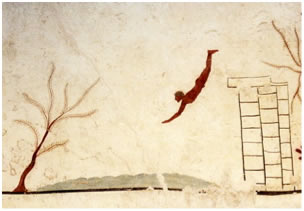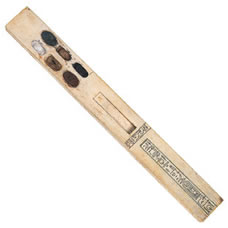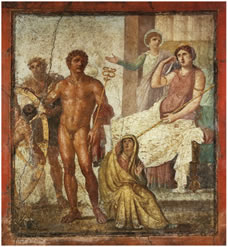Painting techniques
The Minoans are attributed with inventing the fresco by applying pigments directly to a fresh lime surface. The pigments they used were earth pigments because they were unaffected by alkalis.
Egyptian artists covered limestone walls of tombs with a fine layer of plaster, onto which they painted various scenes. Painters used primarily black, red, yellow, brown, blue, and green pigments. They mixed their colors in a binder to make them stick to the dry plaster. Paints were made by using the ground pigment with gums or animal glue, which made them workable and fixed them to the surface being decorated.
The encaustic painting technique was used widely in Greece and Rome for easel pictures. In this technique, the binder for the pigment is wax or wax and resin. Wax and eggs wer used in ancient Egypt and Rome as media for pigments. Examples of encaustic tomb portraits from Roman Egypt bear witness to the durability of the medium, which is thought to have been widely used in ancient times.
The Egyptian six color palette
The Ivory Palette of Merytaten
This palette was found in the Treasury between the paws of the jackal mounted on a shrine. This palette, being a gift from Princess Merytaten to Tutankhamen, can’t be an ordinary scribe’s palette. Instead, with its six cavities for paint, it was a painter’s palette.
The palette
Egyptians
The use of color in Egyptian paintings was highly symbolic and strictly regulated. Egyptian painters relied on six colors in their palette: red, green, blue, yellow, white, and black.
Madder and Indigo were known principally as textile dyes, but may also have been employed in ink form as artists’ pigments.
Iron oxide pigments (red ochre, yellow ochre and umber) constituted the basic palette of Egyptian artisans. Among the various artifacts found in Tutankhamen’s tomb (meant to accompany King Tut in his journey to the afterlife) was a small paint box. The paint box was found to contain powders of orpiment, red ochre, and malachite.
The Egyptians began serious color manufacturing from about 4000 BC. They introduced the washing of pigments to increase pigments’ strength and purity. They also produced new materials, the most famous of which was Egyptian blue-first made around 3000 BC. The Egyptians also used azurite and realgar. Vegetable dyes were also developed, and the Egyptians were the first to fix dyes onto a transparent white powder base to produce pigments (madder lake, carmine lake). This is the process known as lake making. Solutions of organic dyes extracted from parts of plants were mixed with hydrated clay or tannin to form an insoluble pigment. The Old Masters used chalk or alum for this purpose.

A rare Greek wall painting
Tomb of the Diver, 470 BC, Paestum
Fresco from the Tomb of the Diver, dating from 470 BC. It was found in the Area Tempa del Prete in Paestum. These frescoes are the only example of Greek wall painting with figured scenes from the Archaic or Classical periods to survive in their entirety. Close examination of the paintings shows the working practices of the artists. Technically, these are similar to those of the painters of Etruscan tombs of the period. The diver may make reference to the moment of death and the symposium may have been intended to create a welcoming scene to surround the dead man in the tomb.
Greeks
The Greeks’ contribution to painting was the manufacture of lead white, which remained the most used white pigment available to artists until the 19th century. The Greeks also developed the use of red lead.
House of the Vettii; Pompeii encaustic painting
Punishment of Ixion, House of the Vettii, Pompeii
In 79 B.C., the artists of Herculaneum and Pompeii were painting most of their murals with wax, using a process called wax emulsion or Punic wax. Pliny described the process as boiling beeswax with salt water and potassium carbonate, and then bleaching in the sun, leaving the wax a paste consistency
Romans
The Romans made use of the pigments developed by the Egyptians and Greeks. Vermilion was mined at Almaden in Spain to provide the Romans with the pigment. It was extensively used in wall decorations in the houses of the wealthy in Pompeii; gladiators and statues were painted with it and it was worn by Roman women as lipstick. Based on its strength of color, vermillion was used into the 19th century.


